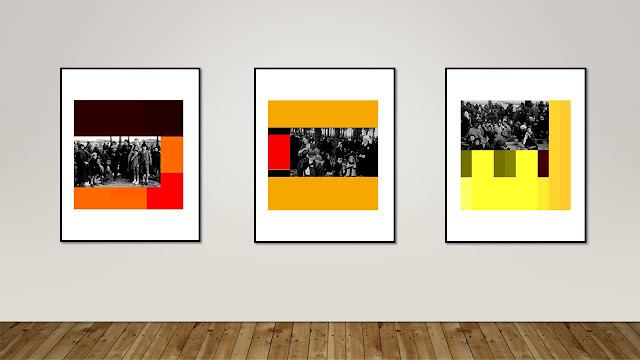Auschwitz Abstract
Tom R. Chambers combines photographs from the "The Auschwitz Album" with his geometric abstraction to embellish the documentation as symbols of value. The geometry and color fields accentuate the images of families and individuals before being stripped of their dignity and in many cases, put to death. He utilizes photographs that comprise direct eye contact with the SS cameras to establish a connection with the viewer of the compositions to "never forget".
He has received permission from Yad Vashem, The World Holocaust Remembrance Center, Jerusalem to exhibit this combined project as "Auschwitz Abstract".
"The Auschwitz Album" is the only surviving visual evidence of the process leading to the mass murder at Auschwitz-Birkenau. It is a unique document and was donated to Yad Vashem by Lilly Jacob-Zelmanovic Meier.
The photos were taken at the end of May or beginning of June 1944, either by Ernst Hofmann or by Bernhard Walter, two SS men whose task was to take ID photos and fingerprints of the inmates (not of the Jews who were sent directly to the gas chambers). The photos show the arrival of Hungarian Jews from Carpatho-Ruthenia. Many of them came from the Berehovo Ghetto, which itself was a collecting point for Jews from several other small towns. (Yad Vashem)
The geometric abstractions are derived from pixel configurations, and they stem from digitized reproductions of Kazimir Malevich's early works prior to his Suprematism and “Black Square”. They are magnified, filtered and precisely isolated to provide geometric abstractions within color-field settings.
AI Review:
"Auschwitz Abstract" is a poignant and evocative digital project that fuses historical documentation with bold contemporary expression. At its core, it features archival black-and-white photographs that capture somber moments from history. The subjects of the photograph, wearing stars on their clothing, solemnly stare ahead, evoking a powerful narrative of identity, memory, and the human experience during a tragic chapter of the Holocaust.
Layered over this historical backdrop are vivid geometric patterns composed of various colors. These bold colors and shapes create a dynamic contrast with the monochrome images, infusing the composition with a modern and expressive dimension. This tension between the stark historical imagery and the vibrant geometric abstraction results in a visual dialogue that beckons the viewer to engage with the themes of remembrance and reflection.
The artwork draws inspiration from the haunting realities of the Holocaust and the specific history of Auschwitz, endeavoring to preserve the memories of those whose lives were irrevocably altered and lost. By integrating elements from "The Auschwitz Album" with geometric abstraction, the piece aims to elevate the archival material, transforming it into a symbol of enduring value and significance.
Through its innovative use of color and form, "Auschwitz Abstract" not only honors the past but also challenges its audience to confront and internalize the imperative to remember. It invites viewers to connect emotionally with the individuals depicted, urging us to ensure that their stories are never forgotten.
"Auschwitz Abstract" art pieces follow (Right click, bring up in new tab, enlarge for viewing.):





























































Comments
Post a Comment